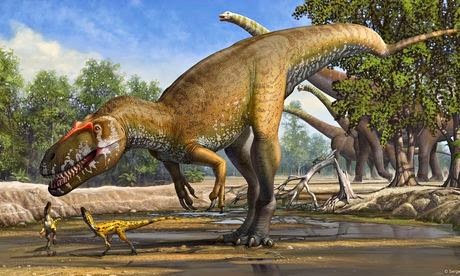
Fossilised remains of what scientists believe was the largest terrestrial predator ever to have roamed Europe have been found in Portugal.
The dinosaur, a new species named Torvosaurus gurneyi, was up to 10m (33ft) long and weighed between four and five tonnes.
Its head measured 1.15m from front to back and was filled with blade-shaped teeth up to 10cm (4in) long, suggesting it may have been near the top of the food chain and eaten other large dinosaurs.
Scientists found the bones north of Portugal’s capital, Lisbon, and originally thought they belonged to a species from North America, Torvosaurus tanneri.
But comparisons of the shin bone, upper jawbone, teeth, and partial tail vertebrae suggested it was a new species, making it one of the largest carnivorous dinosaurs of the Jurassic period found in this area, living around 150 million years ago.
The new dinosaur is the second species of Torvosaurus to be named, and scientists believe recently-discovered embryos from Portugal also belong to it. The number of teeth, as well as the size and shape of the mouth, are though to differentiate the European and the American Torvosaurus.
The fossil of the upper jaw of Torvosaurus tanneri has 11 or more teeth, while Torvosaurus gurneyi has fewer than 11, and the mouth bones have a different shape and structure. Fossilised remains of other closely related dinosaurs suggest Torvosaurus gurneyi may have been covered with “protofeathers” – the precursors of bird feathers.
The findings were published in the online journal PLOS ONE. Report co-author Christophe Hendrickx said: “This is not the largest predatory dinosaur we know. Tyrannosaurus, Carcharodontosaurus, and Giganotosaurus from the Cretaceous were bigger animals.
“With a skull of 115cm, Torvosaurus gurneyi was however one of the largest terrestrial carnivores at this epoch, and an active predator that hunted other large dinosaurs, as evidenced by blade-shape teeth up to 10cm.”
• This article was amended on 6 March 2014. The original suggested the newly discovered species was the largest of any terrestrial dinosaur found in Europe. This has been corrected.
Note : The above story is based on materials provided by Press Association










